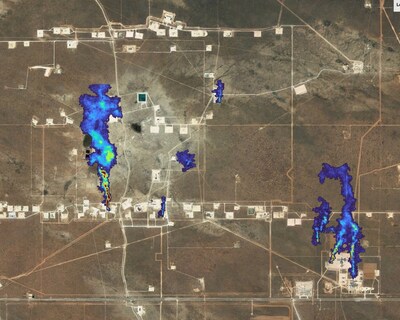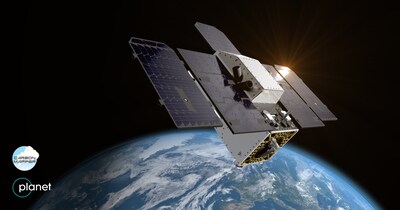Carbon Mapper Coalition launches Tanager-1 satellite to drive transparency of methane and CO2 super-emitters and prompt global action
Rhea-AI Summary
The Carbon Mapper Coalition has successfully launched Tanager-1, its first satellite, into orbit. Developed by Planet Labs (NYSE: PL) with NASA's Jet Propulsion Laboratory technology, Tanager-1 aims to pinpoint methane and CO2 super-emitters globally. This satellite is part of a public-private partnership to drive transparency and action on emissions reduction.
Tanager-1's unique capabilities allow it to detect methane super-emitters that emit >100 kg/hour across fossil fuel, waste, and agriculture sectors. The satellite will provide high-resolution observations to empower industry, policymakers, and civil society to reduce emissions at the source. Carbon Mapper plans to make this data publicly available on its online portal, advancing transparency and accountability in emissions reduction efforts.
Positive
- Successful launch of Tanager-1 satellite to detect methane and CO2 super-emitters
- Public-private partnership leveraging Planet Labs' (NYSE: PL) technology and expertise
- Potential to identify and mitigate previously unknown super-emitting events
- Plan to make emissions data publicly available for noncommercial use
Negative
- None.
News Market Reaction 1 Alert
On the day this news was published, PL gained 12.70%, reflecting a significant positive market reaction.
Data tracked by StockTitan Argus on the day of publication.
VANDENBERG SPACE FORCE BASE, Calif., Aug. 16, 2024 /PRNewswire/ -- Today, the Carbon Mapper Coalition's first satellite, Tanager-1, was successfully launched into orbit on the SpaceX Transporter-11 Rideshare mission. The satellite was developed by Planet Labs (NYSE: PL) with technology from NASA's Jet Propulsion Laboratory (JPL). The launch marks a critical milestone in Carbon Mapper's work to drive local action on methane and CO2 super-emitters, globally.
Tanager-1 is the first of a series of satellites being developed and deployed through a unique public-private partnership powered by philanthropy that brings together diverse technical, scientific, engineering and policy expertise to accomplish bold emission reduction objectives. The coalition, led by the nonprofit Carbon Mapper, includes JPL, Planet Labs, RMI and Arizona State University alongside philanthropic supporters including High Tide Foundation, Grantham Foundation for the Protection of the Environment, Bloomberg Philanthropies, Children's Investment Fund Foundation and Zegar Family Foundation, among others.
"There is more momentum than ever to act on climate. But a lack of public and private investment in global methane and CO2 monitoring has left gaps that leave many emissions untracked and unaddressed," said Richard Lawrence, Founder and Executive Chairman of High Tide Foundation. "With the launch of Tanager-1 we are scaling up high impact monitoring to drive transparency of super-emitters everywhere and grow society's collective capacity to be a big part of the solution."
"Data from this satellite will dramatically improve our ability to pinpoint leaks of methane and CO2 and ensure action is taken to stop them," said Michael R. Bloomberg, the United Nations Secretary-General's Special Envoy on Climate Ambition and Solutions and Founder of Bloomberg L.P. and Bloomberg Philanthropies. "It's a great example of how new technology can lead to more transparency and faster progress in cutting emissions — which is needed to avoid the worst impacts of climate change."
Methane is over 80 times more powerful at retaining heat in the atmosphere than CO2, contributing to about
Tanager's unique capabilities complement other emissions-detecting sensors in orbit by zooming in on methane super-emitters — facilities or equipment that emit >100 kilograms per hour — across the fossil fuel, waste and agriculture sectors. The Tanager-1 satellite will provide observations with unprecedented granularity to empower industry, policymakers, regulators, and civil society to take actions that reduce emissions at the source. In addition to slowing climate change, mitigating methane will dramatically improve air quality by reducing co-emitted toxic air pollutants, protecting vulnerable communities and improving public health.
"Methane super-emitters represent a disproportionate climate risk and opportunity — contributing up to 20–
Through years of regional demonstration pilots leveraging aircraft equipped with imaging spectrometers (including Arizona State University Center for Global Discovery and Conservation Science's Global Airborne Observatory and JPL's AVIRIS-NG), Carbon Mapper found that nearly half of super-emitting events flagged for state agencies and operators were previously unknown, and once identified, were able to be mitigated.
"The launch of Tanager-1 continues the crucial work of locating greenhouse gas emissions sources with a degree of resolution that will enable stakeholders to take action," said James Graf, director of JPL's Earth Science and Technology Directorate. "We are excited to see the JPL imaging spectrometer technology providing direct societal impact. We also see great promise in tackling other environmental challenges through public-private partnerships as demonstrated by the Carbon Mapper Coalition."
"The Tanager-1 mission will use incredible technology to pinpoint emitters and guide action to stop them. This is a remarkable coalition that we are incredibly proud to be a part of," said Will Marshall, Co-Founder and CEO of Planet. "Combining cutting-edge imaging spectrometer technology from JPL with an innovative smallsat bus from Planet and data processing from Carbon Mapper, the consortium itself is a powerful example of actors coming together to solve hard world challenges. We expect its impact on methane emitters to have a lasting, positive impact on the planet."
A core part of Carbon Mapper's mission is making its methane and CO2 data and insights available on its public online portal for noncommercial use. Today, the portal includes tens of thousands of plumes observed from air and space and soon will include methane data from Tanager-1. With this powerful tool, the organization is advancing data transparency and accessibility that can strengthen societal awareness on the exact sources of emissions, prompt mitigation action, improve accountability, prioritize solutions and investments, and help us reduce emissions quickly to meet bold climate goals.
Special Note to Reporters:
More information, including image and video footage can be found in our press package here.
About Carbon Mapper
Carbon Mapper is a nonprofit based in
![]() View original content to download multimedia:https://www.prnewswire.com/news-releases/carbon-mapper-coalition-launches-tanager-1-satellite-to-drive-transparency-of-methane-and-co2-super-emitters-and-prompt-global-action-302224666.html
View original content to download multimedia:https://www.prnewswire.com/news-releases/carbon-mapper-coalition-launches-tanager-1-satellite-to-drive-transparency-of-methane-and-co2-super-emitters-and-prompt-global-action-302224666.html
SOURCE Carbon Mapper Inc.










